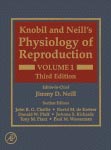Chapter 22 - The Epididymis
B Robaire, BT Hinton, MC Orgebin-Crist
Plates (1st Edition)
Fig. 62
Montage of a clear cell of the cauda epididymis
Figs. 63-65
High power of the apical region of a clear cell of the cauda epididymis showing a large coated pit (Cp) and large coated vesicle (CV), numerous small uncoated vesicles (v), and a large vacuole (V)
High power of the apical region of a clear cell of the cauda epididymis
Supranuclear region of a clear cell of the cauda epididymis
Fig. 66
A basal cell of the caput epididymis, showing an elongated nucleus (N) enclosed by a small amount of cytoplasm containing a Golgi apparatus (G)
Fig. 67
A basal cell of the cauda epididymis
Fig. 68
A halo cell in the lamina propria of the epididymis enclosed by the arms of a myoid cell (MY)
Fig. 69
A halo cell in the basal region of the epididymal epithelium
Fig. 70
Appearance of different organic solutes in the lumen of the rat and hamster (*) proximal caput, distal caput (a) epididymis (▲), or cauda (■) epididymidis after systemic infusion of the radioactive compound, followed by direct micropuncture or microperfusion of the duct
Fig. 71
Schematic representation of the probable steps in endocytosis, transcytosis, and secretion in principal cells of the epididymis and vas deferens
Fig. 72
Structure of testosterone, dihydrotestosterone, and 5α-androstan-3α,17β-ol and their enzymatic interconversion in the rat epididymis
Fig. 73
Glutathione S-transferase activity in isoelectric focused peaks of sections of the epididymis-vas deferens
Fig. 74
Concentration (mM) of sodium, potassium, chloride, and phosphate in the luminal fluid of rat seminiferous tubules (SNT), rete testis, head (caput), body (corpus) and tail (cauda) of the epididymis
Fig. 75
Densitometric pattern of luminal proteins from the rete testis and epididymis of rams separated by one dimensional SDS polyacrylamide gel electrophoresis













